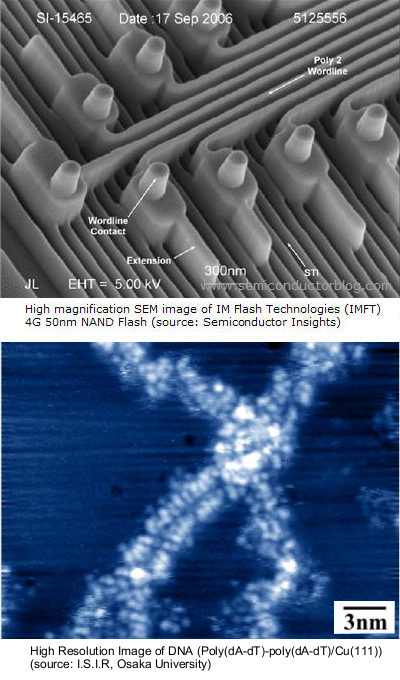USTC/Introduction
From 2007.igem.org
m |
m |
||
| (20 intermediate revisions not shown) | |||
| Line 1: | Line 1: | ||
| - | + | [[Image:USTC_Biologic vs Electronic.png|thumb|right|Comparison of electronic transistor with DNA helix.]] | |
| - | + | It is charming for biology scientists to implement a computer in biological organisms. Primarily, logic circuits made with biological materials can work <i>in vitro</i> [1]. More to the point, attempts to carry out unique logic gates <i>in vivo</i> have been reported [2]. Here, our team has been trying to work out a systematic method to realize an extensible logical circuit <i>in vivo</i>. | |
| + | |||
| + | As the basic elements of the logic circuits, AND, OR and NOT (or NAND, NOR and NOT) gates should be implemented in the first instance. Transcriptional regulation, which is widely found in biological organism, can be considered as a kind of switch. It serves as the basis of the logic gates <i>in vivo</i>. A negative transcriptional regulation is utilized as a NOT gate. The NOR and NAND gates are realized by installing two operator at the proper distance. All the gates are made on a 60~200-bp DNA fragments in this way. | ||
| + | |||
| + | To transmit signals between the gates is more complex <i>in vivo</i> than to do so in vitro. The signal messengers should be specific enough to avoid interference among them. Also, their life expectancy should be long enough to finish their work. Proteins are employed here to be the messengers. To possess enough binding specificity with DNA, proteins are screened with computational protein design and directed evolution. Highly qualified wires are thus obtained. | ||
| + | |||
| + | Furthermore, by means of assembling all our parts, a demonstration system will be made to drive the integrated system to work <i>in vivo</i>. | ||
| + | |||
| + | ---- | ||
| + | |||
| + | 1. Georg Seelig, David Soloveichik, David Yu Zhang, Erik Winfree, 'Enzyme-Free Nucleic Acid Logic Circuits', <i>Science</i> Vol. 314. no. 5805, pp. 1585 - 1588 (2006) | ||
| + | |||
| + | 2. Yohei Yokobayashi, Ron Weiss, and Frances H. Arnold, 'Directed evolution of a genetic circuit', <i>PNAS</i> (2002) vol 99 no 26 16587–16591 | ||
Latest revision as of 03:06, 27 October 2007
It is charming for biology scientists to implement a computer in biological organisms. Primarily, logic circuits made with biological materials can work in vitro [1]. More to the point, attempts to carry out unique logic gates in vivo have been reported [2]. Here, our team has been trying to work out a systematic method to realize an extensible logical circuit in vivo.
As the basic elements of the logic circuits, AND, OR and NOT (or NAND, NOR and NOT) gates should be implemented in the first instance. Transcriptional regulation, which is widely found in biological organism, can be considered as a kind of switch. It serves as the basis of the logic gates in vivo. A negative transcriptional regulation is utilized as a NOT gate. The NOR and NAND gates are realized by installing two operator at the proper distance. All the gates are made on a 60~200-bp DNA fragments in this way.
To transmit signals between the gates is more complex in vivo than to do so in vitro. The signal messengers should be specific enough to avoid interference among them. Also, their life expectancy should be long enough to finish their work. Proteins are employed here to be the messengers. To possess enough binding specificity with DNA, proteins are screened with computational protein design and directed evolution. Highly qualified wires are thus obtained.
Furthermore, by means of assembling all our parts, a demonstration system will be made to drive the integrated system to work in vivo.
1. Georg Seelig, David Soloveichik, David Yu Zhang, Erik Winfree, 'Enzyme-Free Nucleic Acid Logic Circuits', Science Vol. 314. no. 5805, pp. 1585 - 1588 (2006)
2. Yohei Yokobayashi, Ron Weiss, and Frances H. Arnold, 'Directed evolution of a genetic circuit', PNAS (2002) vol 99 no 26 16587–16591
